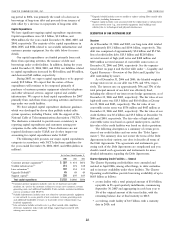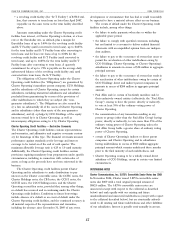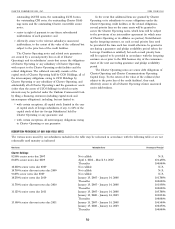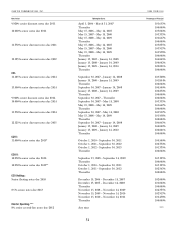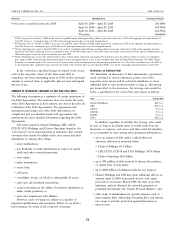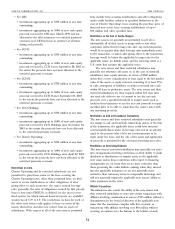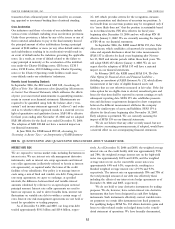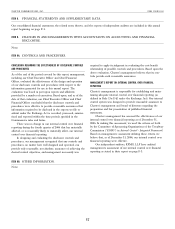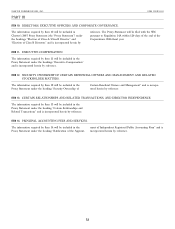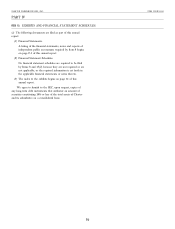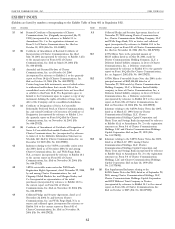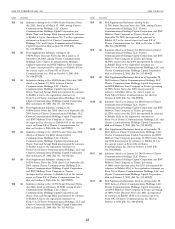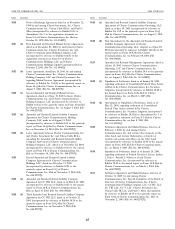Charter 2006 Annual Report Download - page 69
Download and view the complete annual report
Please find page 69 of the 2006 Charter annual report below. You can navigate through the pages in the report by either clicking on the pages listed below, or by using the keyword search tool below to find specific information within the annual report.
CHARTER COMMUNICATIONS, INC. 2006 FORM 10-K
transaction from a financial point of view issued by an account- No. 109, which provides criteria for the recognition, measure-
ing, appraisal or investment banking firm of national standing. ment, presentation and disclosure of uncertain tax positions. A
tax benefit from an uncertain position may be recognized only if
Cross Acceleration it is ‘‘more likely than not’’ that the position is sustainable based
Our indentures and those of certain of our subsidiaries include on its technical merits. FIN 48 is effective for fiscal years
various events of default, including cross acceleration provisions. beginning after December 15, 2006 and we will adopt FIN 48
Under these provisions, a failure by any of the issuers or any of effective January 1, 2007. We are currently assessing the impact
their restricted subsidiaries to pay at the final maturity thereof of FIN 48 on our financial statements.
the principal amount of other indebtedness having a principal In September 2006, the FASB issued SFAS 157, Fair Value
amount of $100 million or more (or any other default under any Measurements, which establishes a framework for measuring fair
such indebtedness resulting in its acceleration) would result in value and expands disclosures about fair value measurements.
an event of default under the indenture governing the applicable SFAS 157 is effective for fiscal years beginning after Novem-
notes. As a result, an event of default related to the failure to ber 15, 2007 and interim periods within those fiscal years. We
repay principal at maturity or the acceleration of the indebted- will adopt SFAS 157 effective January 1, 2008. We do not
ness under the Charter Holdings notes, CIH notes, CCH I expect that the adoption of SFAS 157 will have a material
notes, CCH II notes, CCO Holdings notes, Charter Operating impact on our financial statements.
notes or the Charter Operating credit facilities could cause In February 2007, the FASB issued SFAS 159, The Fair
cross-defaults under our subsidiaries’ indentures. Value Option for Financial Assets and Financial Liabilities —
Including an amendment of FASB Statement No. 115, which allows
Recently Issued Accounting Standards measurement at fair value of eligible financial assets and
In September 2006, the SEC issued SAB 108, Considering the liabilities that are not otherwise measured at fair value. If the fair
Effects of Prior Year Misstatements when Quantifying Misstatements value option for an eligible item is elected, unrealized gains and
in Current Year Financial Statements, which addresses the effects losses for that item shall be reported in current earnings at each
of prior year uncorrected misstatements in quantifying misstate- subsequent reporting date. SFAS 159 also establishes presenta-
ments in current year financial statements. Misstatements are tion and disclosure requirements designed to draw comparison
required to be quantified using both the balance-sheet (‘‘iron- between the different measurement attributes the company
curtain’’) and income-statement approach (‘‘rollover’’) and evalu- elects for similar types of assets and liabilities. SFAS 159 is
ated as to whether either approach results in a material error in effective for fiscal years beginning after November 15, 2007.
light of quantitative and qualitative factors. SAB 108 is effective Early adoption is permitted. We are currently assessing the
for fiscal years ending after November 15, 2006 and we adopted impact of SFAS 159 on our financial statements.
SAB 108 effective for the fiscal year ended December 31, 2006. We do not believe that any other recently issued, but not
The adoption of SAB 108 did not have a material impact on yet effective accounting pronouncements, if adopted, would have
our financial statements. a material effect on our accompanying financial statements.
In June 2006, the FASB issued FIN 48, Accounting for
Uncertainty in Income Taxes — an Interpretation of FASB Statement
ITEM 7A. QUANTITATIVE AND QUALITATIVE DISCLOSURES ABOUT MARKET RISK.
INTEREST RATE RISK tively. As of December 31, 2006 and 2005, the weighted average
interest rate on the credit facility debt was approximately 7.9%
We are exposed to various market risks, including fluctuations in and 7.8%, the weighted average interest rate on the high-yield
interest rates. We use interest rate risk management derivative notes was approximately 10.3% and 10.2%, and the weighted
instruments, such as interest rate swap agreements and interest average interest rate on the convertible senior notes was
rate collar agreements (collectively referred to herein as interest approximately 6.9% and 6.3%, respectively, resulting in a
rate agreements), as required under the terms of the credit blended weighted average interest rate of 9.5% and 9.3%,
facilities of our subsidiaries. Our policy is to manage interest respectively. The interest rate on approximately 78% and 77% of
costs using a mix of fixed and variable rate debt. Using interest the total principal amount of our debt was effectively fixed,
rate swap agreements, we agree to exchange, at specified including the effects of our interest rate hedge agreements as of
intervals, the difference between fixed and variable interest December 31, 2006 and 2005, respectively.
amounts calculated by reference to an agreed-upon notional We do not hold or issue derivative instruments for trading
principal amount. Interest rate collar agreements are used to purposes. We do, however, have certain interest rate derivative
limit our exposure to, and to derive benefits from, interest rate instruments that have been designated as cash flow hedging
fluctuations on variable rate debt to within a certain range of instruments. Such instruments effectively convert variable inter-
rates. Interest rate risk management agreements are not held or est payments on certain debt instruments into fixed payments.
issued for speculative or trading purposes. For qualifying hedges, SFAS No. 133 allows derivative gains and
As of December 31, 2006 and 2005, our long-term debt losses to offset related results on hedged items in the consoli-
totaled approximately $19.1 billion and $19.4 billion, respec- dated statement of operations. We have formally documented,
55



